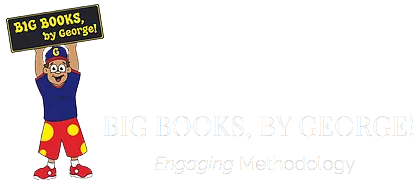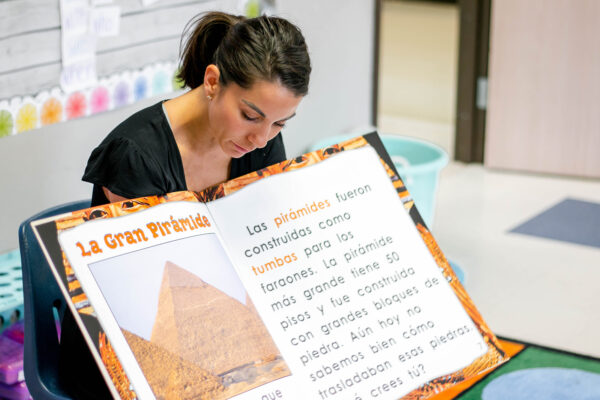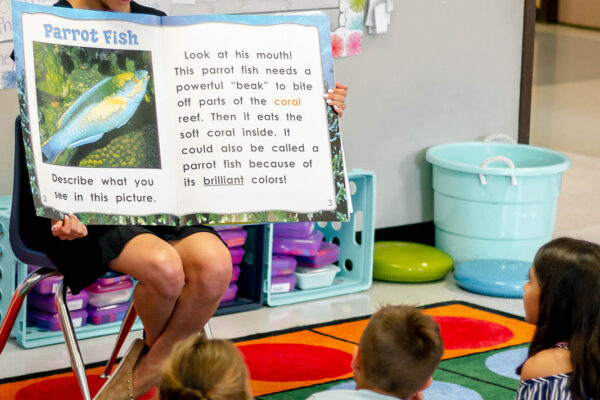Using a mentor text during shared reading is a no brainer when it comes to teaching writing and reading structures. For preschool and elementary age children, one page can take an entire literacy block- there is just so much to cover!
From vocabulary and asking the right questions to hammering out structures and formulas for successful writing patterns, utilizing a solid mentor text can be hugely beneficial. Narrative mentor texts can achieve many of these, but nonfiction mentor texts can hold a specific place in shared reading to demonstrate informational writing and organization of ideas. When it comes to TELPAS for English Learners, the more opportunities, the better!
But first, to structure a strong shared reading takes a few key steps.
Structuring a Shared Reading Lesson
Becky, from the popular blog Lessons by the Lake, recommends that a good shared reading lesson includes a small dose of directed instruction, a little more of modeling think aloud, and the majority includes interactive student practice. You can check out her graphic here. Directed instruction helps students to understand the structure of the shared reading lesson. Modeling think aloud is necessary for teaching students what features of a text provide context clues or patterns of speech typical for that type of text. Interactive student practice allows a safe, non-threatening environment to work out possible conclusions and identify speech patterns to later aid them in contextual reading and writing.
A Few Extra Tips for Shared Reading
Christina Gil, writing for Edutopia has a few tips on how to structure mentor texts in the classroom as well. Gil hones in on vocabulary and detailed explanations of a few words to really direct the lesson with a mentor text. She also suggests reading a book aloud together, and then giving time for students to read it themselves later.
What’s great about doing shared reading with a mentor text is that you can walk through the book very slowly. One page may take an entire daily lesson. For example, using our non-fiction big books, each page is a stand alone chapter. Even though all the chapters are relevant to the title, they can provide tons of different opportunities for modeling writing and reading with a non-fiction text. It can take an entire week to get through the whole book. But to know which direction to go with nonfiction shared reading, there are a few unique things to keep in mind.
Shared Reading with a Non fiction Mentor Text
When it comes to non-fiction texts, informational writing and personal conclusions are more frequent. Ciera Harris of Ciera Harris Teaching highlights the main features of non-fiction text, which are Descriptive, Compare and Contrast, Sequential, Cause and Effect, and Problem and Solution.
In order to best prepare students to understand and take in the information, and be able to organize it well enough to write about it, using these 5 methods
5 tips for Teaching Nonfiction Reading and Writing
- Text features – What specific features in the text are unique to non-fiction? This could be as simple as pointing out diagrams, timelines, or captions. Something as simple as identifying text features can help to build an organizational method for students to categorize information, freeing up space in the working memory for the essentials.
- Graphic Organizers – Who doesn’t love a great graphic organizer?! Venn Diagrams, Timelines, Cause and Effect Trees- these all apply. And here at Big Books, by George! We’ve even created wipeable graphic organizer charts that go right on top of our big books to help out with shared reading.
- Only Using Key Words – As tempting as it may be to focus on those nice bolded words, a good nonfiction mentor text focuses on the subject as a whole. This means that it may be better to hold off onto focusing on key words until the end of the lesson. Then, it’s easier to integrate the information with actual definitions.
- Differences between nonfiction and fiction – Because there are distinctive differences between types of texts, pointing out nonfiction characteristics help orient a student towards a more specific writing approach. Things such as point of view, sentence starters, and opinion vs. fact can be easily highlighted and identified.
- Relate to the main idea – In the same way that we teach students to write with narrative texts, such as identifying the main idea, the message, and the purpose, nonfiction texts need to have a conclusion or idea. This centers writing around a formulaic purpose, and with practice, will help to cultivate an informative and cohesive writing style.
A few more key Tips
Sara Marye has a few more tips for mentor texts that support non-fiction shared reading. Firstly, she suggests using many books by the same author to get a sense of a way information can be organized. Secondly, she suggests having those same titles in classroom libraries. At Big Books, by George! We do just that with our sets. Students can take the same text to their desk as what was read from a big book.
Shared Reading blocks are incredibly beneficial for reading and writing, especially when it comes to English Learners. Whether it’s to aid in comprehension, language acquisition, or enhancing writing skills, a carefully crafted shared reading lesson will take it to the next level.




